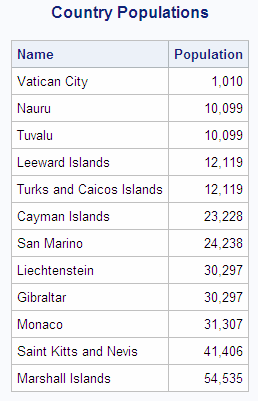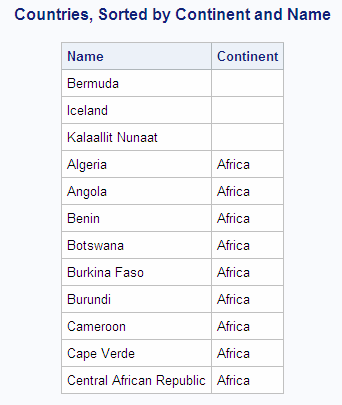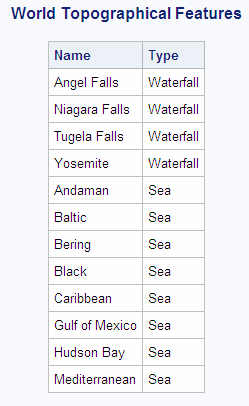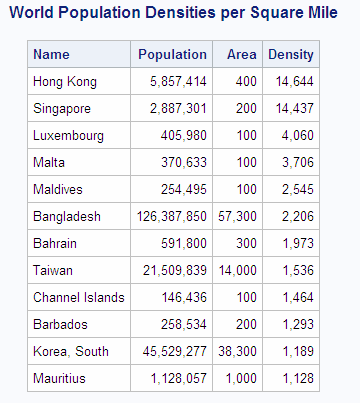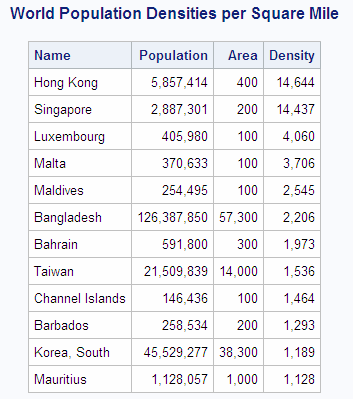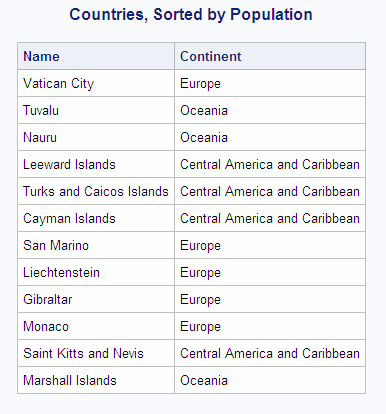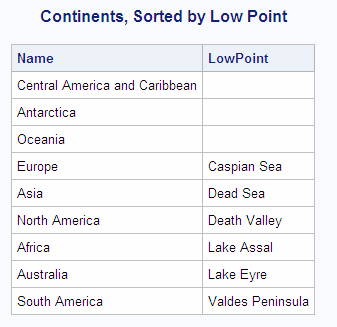Sorting Data
Overview of Sorting Data
You can sort
query results with an ORDER BY clause by specifying any of the columns
in the table, including columns that are not selected or columns that
are calculated.
Unless an ORDER BY clause
is included in the SELECT statement, then a particular order to the
output rows, such as the order in which the rows are encountered in
the queried table, cannot be guaranteed, even if an index is present.
Without an ORDER BY clause, the order of the output rows is determined
by the internal processing of PROC SQL, the default collating sequence
of SAS, and your operating environment. Therefore, if you want your
result table to appear in a particular order, then use the ORDER BY
clause.
For more information
and examples, see the ORDER BY Clause.
Sorting by Column
The
following example selects countries and their populations from the
SQL.COUNTRIES table and orders the results by population:
libname sql 'SAS-library';
proc sql outobs=12;
title 'Country Populations';
select Name, Population format=comma10.
from sql.countries
order by Population;Sorting by Multiple Columns
You can sort by more
than one column by specifying the column names, separated by commas,
in the ORDER BY clause. The following example sorts the SQL.COUNTRIES
table by two columns, Continent and Name:
Specifying a Sort Order
To order the
results, specify ASC for ascending or DESC for descending. You can
specify a sort order for each column in the ORDER BY clause.
When you specify multiple
columns in the ORDER BY clause, the first column determines the primary
row order of the results. Subsequent columns determine the order of
rows that have the same value for the primary sort. The following
example sorts the SQL.FEATURES table by feature type and name:
Sorting by Calculated Column
You can sort by a calculated column by specifying its
alias in the ORDER BY clause. The following example calculates population
densities and then performs a sort on the calculated Density column:
Sorting by Column Position
You can sort by any column
within the SELECT clause by specifying its numerical position. By
specifying a position instead of a name, you can sort by a calculated
column that has no alias. The following example does not assign an
alias to the calculated density column. Instead, the column position
of 4 in the ORDER BY clause refers to the position of the calculated
column in the SELECT clause:
libname sql 'SAS-library';
proc sql outobs=12;
title 'World Population Densities per Square Mile';
select Name, Population format=comma12., Area format=comma8.,
Population/Area format=comma10. label='Density'
from sql.countries
order by 4 desc;Sorting by Columns That Are Not Selected
You can sort query results
by columns that are not included in the query. For example, the following
query returns all the rows in the SQL.COUNTRIES table and sorts them
by population, even though the Population column is not included in
the query:
Specifying a Different Sorting Sequence
SORTSEQ=
is a PROC SQL statement option that specifies the sorting sequence
for PROC SQL to use when a query contains an ORDER BY clause. Use
this option only if you want to use a sorting sequence other than
your operating environment's default sorting sequence. Possible values
include ASCII, EBCDIC, and some languages other than English. For
example, in an operating environment that supports the EBCDIC sorting
sequence, you could use the following option in the PROC SQL statement
to set the sorting sequence to EBCDIC:
proc sql sortseq=ebcdic;
Sorting Columns That Contain Missing Values
PROC SQL sorts nulls, or missing values, before character
or numeric data. Therefore, when you specify ascending order, missing
values appear first in the query results.
libname sql 'SAS-library';
proc sql;
title 'Continents, Sorted by Low Point';
select Name, LowPoint
from sql.continents
order by LowPoint; Because three continents
have a missing value in the LowPoint column, those continents appear
first in the output. Note that because the query does not specify
a secondary sort, rows that have the same value in the LowPoint column,
such as the first three rows of output, are not displayed in any particular
order. In general, if you do not explicitly specify a sort order,
then PROC SQL output is not guaranteed to be in any particular order.
Copyright © SAS Institute Inc. All rights reserved.
